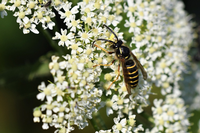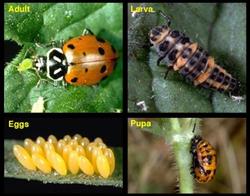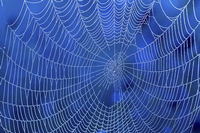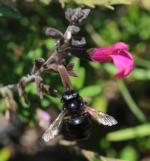Beneficial Insects
Beneficial insects help us in our gardens by pollinating plants, preying on other pests such as aphids, adding beauty, and being part of a whole, healthy ecosystem. Below is a collection of our monthly tips that relate to beneficial insects.
Beneficial Insects Tips
Attracting BeesBees are pollination workhorses, increasing garden production. Many plants will not produce fruit unless flowers are pollinated. Colorful annuals, such as Cosmos, edible African Blue Basil, and Salvias attract bees. You can also allow herbs and other plants to flower to create bee-friendly landscapes. The University of California at Davis has a garden dedicated to bees. The Honey Bee Haven website has more resources, including a list of plants they grow. |
Bee SwarmsBees are very active in warm weather. There is simply so much pollen and nectar to collect! Sometimes, a bee colony may swarm. If you see a swarm, don’t panic. As in any other time when working around bees, remain calm, move gently, and give them their space. Bees generally swarm when they are looking for a new home. Swarming bees are loaded with food and are not interested in stinging people. Contact the Bee Guild to have swarms removed. |
Bug PatrolIt’s never helpful to have critters competing with you for your food. Damage can be done by squirrels, raccoons, rats, birds, and caterpillars, yet it is the tiniest creatures that can be the hardest to detect. That’s why it’s helpful to do a regular inspection, as often as once or twice a day if possible. Knowing what it is will help you figure out what to do to maximize the productivity of your garden. Some pests are out during the day and others do their damage at night, so you may want to take a flashlight out at non-peak gardening hours. Holding a piece of white paper under a plant and shaking the plant can make insects fall off for identification. The most common place to find pests is on the undersides of leaves so make sure to closely inspect those parts. A magnifying glass of some sort is a useful tool. You can also take a picture with your cell phone and then zoom in for a closer view. It’s important to be able to recognize the eggs, the larval and nymph stages, and the adult form, and to be able to differentiate between beneficial insects and harmful pests. Don’t indiscriminately squish everything that moves! Once you have done your detective work, you can go to the University of California IPM website for identification and management tips, or contact the Master Gardener Help Desk for guidance.
More Information: Beneficial Predators – These are the ones you want!
|
Carpenter Bees
|
Creating a Pollinator GardenPollination is the process of transferring pollen from the anthers of a flower to the stigma. It is a requirement for the production of fruits and seeds. In addition to wind and water, pollinators include bees, hummingbirds, butterflies, moths, bats, flies, and beetles. You can support the pollination process—and help counter habitat destruction—by selecting plants attractive to common pollinators. UC has many resources for planning a pollinator garden. Here are a few to get you started!
|
EarwigsEarwigs are third only to snails and slugs in causing plant damage. While they are beneficial because they eat insects such as aphids, they also feed on soft plants. Earwigs can do quite a lot of damage if there is a high population. They feed at night and hide in moist, tight-fitting places during the day. Trap them by putting out moistened, tightly rolled newspaper or corrugated cardboard in the evening. In the morning dispose of the paper and the trapped insects. Other control methods are described in the UC Pest Note on Earwigs. |
Flowers To Attract Beneficial InsectsCertain flowers help attract natural enemies of pest insects in the garden. Tiny wasps that parasitize certain insect pests or their eggs need pollen and nectar to survive. Predatory insects (syrphid fly larvae, lady beetles, lace wings, and many others) and mites survive on pollen and nectar from flowers when pest populations are low, and some feed on pollen in order to reproduce. Most of these beneficial insects are small, and so the best flowering plants to include in the garden are those that have small flowers that have pollen and nectar easily accessible and that bloom throughout the season. Avoid flowers that are difficult to weed out when they reseed. Many flowers that attract beneficial insects are easy to start from seed and this month is a good time to start them – some indoors any time or outdoors later in the month after frost danger has passed. Examples include sunflowers (try dwarf varieties like ‘Sunspot’ for smaller spaces), calendula, cosmos and many herbs like dill, basil and borage. Other flowers and herbs that attract beneficial insects are easier to buy as plants. A few examples that can be planted this month are coreopsis, asters, and thyme. Reference info: |
How to Attract and Maintain Pollinators in Your GardenUC ANR has a publication titled "How to Attract and Maintain Pollinators in Your Garden" that discusses the benefits of providing flowers for pollinators and has a list of pollinator plants that are successful in most California gardens. |
Identifying Beneficial Insects
More information: Beneficial Insects |
Lady Beetle
Lady beetles develop through four life stages: egg, larva, pupa, and adult by Jack Kelly Clark, UCANR
For more information: Aphid Eaters |
Leafcutter Bees - a Beneficial Insect
Rose leaves seem to be their favorite. The hole in the leaf is much larger than an ordinary caterpillar would make and is very smooth as if a miniature cookie cutter was used. The bee can chew off a leaf fragment in less then a minute with its sharp jaws. Like all bees, leafcutter bees are important pollinators and should not be killed. |
Plants to Attract ButterfliesButterfly populations fluctuate in response to climate and habitat conditions. Many have specific host plants on which they feed and breed. Some common plants for attracting butterflies are milkweed, lantana, buddleia, and zinnias. For an extensive list of relationships between specific butterflies and host plants, see Art Shapiro's Butterfly Site at UC Davis. |
Spiders in Your Garden
Spider web, Johns Hopkins University
More information: Arachnophobia Video |








 Female carpenter bees are large, black and shiny. Male carpenter bees are similar in appearance to bumble bees. Both are about an inch long. Males do not sting and females sting only rarely. Carpenter bees are considered beneficial insects because they pollinate many plants and trees. For their nests, they tunnel into unpainted softwoods such as pine, fir and redwood in house or garden structures. Adults over winter in the nests, emerge in the spring, mate, deposit food in the tunnels and lay eggs. The tunnels are sealed with wood pulp and the new adults chew their way out. After the bees emerge, fill the holes with steel wool and wood filler. Apply paint to the surface to prevent re-entry. Further information is available in the
Female carpenter bees are large, black and shiny. Male carpenter bees are similar in appearance to bumble bees. Both are about an inch long. Males do not sting and females sting only rarely. Carpenter bees are considered beneficial insects because they pollinate many plants and trees. For their nests, they tunnel into unpainted softwoods such as pine, fir and redwood in house or garden structures. Adults over winter in the nests, emerge in the spring, mate, deposit food in the tunnels and lay eggs. The tunnels are sealed with wood pulp and the new adults chew their way out. After the bees emerge, fill the holes with steel wool and wood filler. Apply paint to the surface to prevent re-entry. Further information is available in the  Do your rose bush leaves have smooth round holes in them? The likely culprit is the female leafcutter bee. The bee cuts smooth round or oval leaf fragments and uses them to line each underground brood cell that she fills with nectar and pollen. When the cell is ready, a single egg is sealed inside. The larva pupates (matures) in the chamber and emerges in the spring.
Do your rose bush leaves have smooth round holes in them? The likely culprit is the female leafcutter bee. The bee cuts smooth round or oval leaf fragments and uses them to line each underground brood cell that she fills with nectar and pollen. When the cell is ready, a single egg is sealed inside. The larva pupates (matures) in the chamber and emerges in the spring.